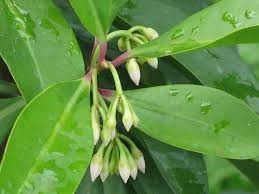Christmas berry
(Ardisia crenata crenata)

Description
Ardisia crenata is a species of flowering plant in the primrose family, Primulaceae, that is native to East Asia. It is known by a variety of names such as Christmas berry, Australian holly, coral ardisia, coral bush, coralberry, coralberry tree, hen's-eyes, and spiceberry. A. crenata is a compact shrub that reaches 1 metre (3.3 ft), often with a single stem. Leaves are dark green, thick, glossy, and have tightly waved edges The flowers are small, white or reddish, fragrant, and form clusters. The fruit is a glossy, bright red drupe. The seeds are able to germinate under a dense canopy and are dispersed by birds and humans. This invasive species was introduced to the United States in the early twentieth century as an ornamental species. It was observed to have escaped cultivation in 1982. Preparations made from the root of Ardisia crenata are used as an ingredient in traditional Chinese medicine. Christmas berry is an upright perennial shrub that grows 1.5–6 feet (0.46–1.83 m) tall. It maintains a caespitose growth pattern and is often multi-trunked. Christmas berry prefers moist soil and germination can occur from pH 4 to pH 10. It does well in temperatures of 25 °C and above. Germination rates are as high as 97.79% after 40 days. Its leaves are simple, alternate and measure up to 8 inches long. They are waxy and dark green with a crenate margin containing small calluses within the ridges. The leaf tips are acuminate and their petioles are 3–10 mm long. They have a central vein with up to 18 pairs of side veins. Flowers are white or pink with yellow anthers and grow in axillary clusters and are very often covered in multiple black spots. Plants begin to bear fruit two years after sprouting. Christmas berry has an abundance of spherical, 1-seeded red berries of about 0.25 inches in diameter that remain on the plant throughout the year. The berry clusters often sag down below the glossy foliage. Berries are dispersed by birds and, when present, raccoons through consumption and subsequent excretion and also by water flow. While there are indications the plant may be poisonous to livestock, pets and humans, due to cattle deaths in Florida, there is no scientific confirmation of this.
Taxonomic tree:







